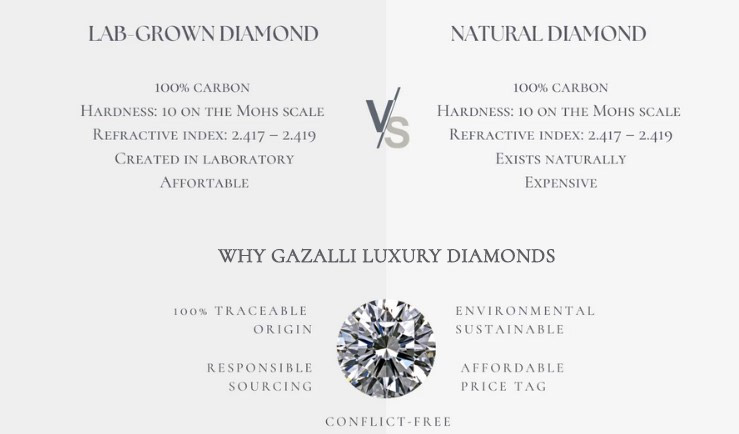
LAB GROWN DIAMONDS
A deep look
What are Labgrown Diamonds?
Labgrown diamonds, also known as lab-grown diamonds, are real diamonds that are not created underground but in specialized laboratories. With advanced technology, these diamonds can be produced in weeks or months, as opposed to the millions of years that natural diamonds require.
How are labgrown diamonds made?
The production of labgrown diamonds is based on two main processes: high temperature high pressure (HTHP) and chemical vapor deposition (CVD). In both processes, real diamond seeds are placed in a controlled environment and allowed to grow under conditions similar to those found inside the Earth.
Are lab-grown diamonds different from natural diamonds?
Chemically, physically and optically, lab-grown diamonds are identical to natural diamonds and are made of 100% carbon. The main difference lies in their origin and the age of the carbon atoms. Only by looking at its age can a special machine be used to determine whether a diamond comes from the laboratory or from the earth.
Are Labgrown Diamonds Ethical?
Yes, labgrown diamonds offer an ethical alternative to traditional diamonds. They do not cause the same ecological damage as diamond mining and are free of the ethical concerns sometimes associated with conventional diamonds.
How expensive are lab-grown diamonds compared to natural diamonds?
Labgrown diamonds typically offer better value for money than their natural counterparts. They can cost between 20% and 40% less without sacrificing quality.
Are labgrown diamonds real diamonds?
Yes, labgrown diamonds are real diamonds with the same physical, chemical and optical properties as natural diamonds. At GAZALLI LUXURY LIMITED we have all of our diamonds from 1 ct certified by IGI.
How do you assess the quality of lab-grown diamonds?
The quality of lab-grown diamonds is assessed according to the same criteria as natural diamonds:
Cut, color, clarity and carat weight.
Why aren’t all lab-created diamonds “flawless”?
A common question that comes up when talking about lab-grown diamonds is why they aren’t all flawless or “flawless” when created in a controlled environment. The process of growing diamonds in the laboratory is an attempt to mimic natural conditions deep in the earth. Although this process takes place in a controlled laboratory, diamonds are grown under extreme conditions of pressure and temperature. These conditions can result in tiny irregularities or “inclusions,” just like in nature. These inclusions and features make each diamond unique and can even help define its character. It is important to understand that “flawless” is a rare and exceptional quality in both natural and lab-grown diamonds. At GAZALLI LUXURY LIMITED Diamonds we strive to offer the highest quality diamonds and we are transparent about what characteristics each diamond has to provide our customers with the best possible selection.
Do Labgrown Diamonds Have Resale Value?
In general, colorless diamonds, whether natural or lab-grown, are not an investment. You should expect to be able to resell them only with a significant loss in value. However, due to the initially lower price of lab-grown diamonds, the absolute loss is lower.
Where can you buy labgrown diamonds?
At GAZALLI LUXURY LIMITED Diamonds we pride ourselves on offering high quality labgrown diamonds that are ethical, environmentally friendly and affordable.
What are the benefits of Labgrown Diamonds?
Not only are labgrown diamonds more ethical and environmentally friendly, but they also offer outstanding value for money without sacrificing quality.
Fears about overproduction of lab-grown diamonds
The fear of overproduction of lab-grown diamonds is understandable, but as with all raw materials, such concerns can arise. Artificial scarcity, as marketed in the field of diamonds from the earth, is one of the most ingenious marketing tools the world has ever seen. The diamond market is in the midst of upheaval. However, even if lab-grown diamonds were available in larger quantities, production and certification would remain costly, preventing prices from falling indefinitely.